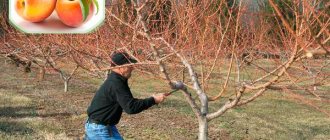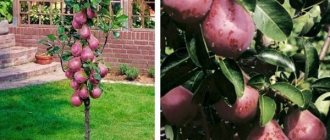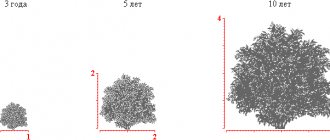Common privet is an ornamental shrub that has long earned popularity among Russian gardeners. First of all, the plant is valued for its versatility, ease of care and the ability to create aesthetic and functional hedges. It is not difficult to plant privet on a plot, as it is unpretentious, grows and spreads quickly, allowing you to create impenetrable thickets. In addition, the bush easily tolerates pruning, and responds to formative pruning with even greater growth activity. The crown can be given a wide variety of shapes, creating amazing three-dimensional green sculptors. The plant is perfect for landscaping populated areas. People call it “wolf berry”.
Important! Berries and leaves of privet are poisonous to humans!
Eating them raw causes gastrointestinal disorders, loss of coordination, and convulsions. In case of severe poisoning, death cannot be ruled out. But ripe dried fruits are still used to prepare medicinal settings and decoctions. Although they are used with caution.
Description
Privet (Ligústrum) is a genus from the Olive family, uniting deciduous, semi- and evergreen shrubs, and low trees. Under natural conditions, ligustrums grow in Europe, including in the south of the European part of the Russian Federation, in the Caucasus, as well as in North Africa, Asia, and Australia. Most representatives of the genus, which includes more than 40 species, are thermophilic. Due to the unpredictable and mostly harsh winters, only certain types of privet are grown in Russian gardening. In particular, ornamental trees and shrubs, which have good winter hardiness and tolerate frosts below 25-30°C.
To briefly describe the common or European privet, it is a shrub or tree whose height does not exceed 5-6 m. The shoots are highly branched. Leathery, ovate, elongated leaves are located opposite on the branches. The flat green leaf blades are lighter on the bottom and darker on the top. In regions with warm climates, common privet grows as an evergreen shrub, and in regions with temperate climates it usually sheds its leaves. The root system is powerful and branched.
In June–July, small white-cream flowers bloom, collected in apical paniculate inflorescences. They have a pronounced fragrant aroma. The fruits are round, shiny, almost black berry-like drupes with 1-4 seeds, which ripen by the end of summer - early autumn and do not fall until the end of winter. Lifespan is about 50-60 years. This species is characterized by fairly fast growth and high winter hardiness.
Evergreen varieties of privet are a worthy analogue of the capricious boxwood. Beautiful ornamental plants are unpretentious and have an affordable price.
Varieties of common privet
This species has several varieties. It is worth studying their characteristics and photos before planting and caring for common privet, since there are some differences.
Aureum
The Aureum variety is slow growing. The bushes are compact, the height does not exceed 1 m. The color of the foliage is yellow and does not change during the season. A distinctive feature of the variety is the lack of flowering.
The Aureum variety is considered semi-evergreen - if there are no frosts in winter, some of the leaves will remain until spring
Vicar
The Vicari variety is semi-evergreen. Its height reaches 1 m. The perennial has a dense crown with wide oval golden-yellow leaves. In autumn their color changes to bronze-violet. The length of the leaves is up to 6 cm. This variety requires shelter for the winter.
The flowers of Privet Vicar are white, small and fragrant, appearing in mid-summer
Atrovirens
The Atrovirens variety is tall. The bushes reach a height of 3-4 m. The foliage color is dark green, changing to purple-white in the fall. White flowers are collected in dense panicles.
This variety is undemanding to the type and composition of the soil and has high winter hardiness. The perennial is suitable for forming on a trunk.
The Atrovirens variety lends itself well to shaping and is suitable for creating outdoor bonsais.
Glaucum
Variety Glaucum (Glaucum) is low-growing. The bushes do not exceed 1 m in height. This perennial has oblong leaves. Distinctive features are a bluish tint and a narrow white border along the edges of the plates.
Comment! The Glaukum variety is considered one of the most decorative, although it does not bloom. For the winter he needs shelter.
Privet Glaucus prefers sunny areas and fertile soil
Variety of species and varieties with photos
In addition to the ordinary one, other types of privet are used in garden landscape design and for landscaping park areas, which differ in the shape of the crown, the color of the leaves, buds and fruits.
- Brilliant is an evergreen tall shrub with a spreading crown and oblong, ovoid, glossy plastic leaves up to 15 cm long. The flowers are white, collected in long panicles. It blooms for quite a long time - about 3 months. It is grown mainly in the southern regions, as it does not tolerate frosts below 15°C.
- Tupolistnaya is a deciduous ornamental shrub, up to 3 m high, with a densely branched and widely spreading crown and slightly hanging branches. It grows relatively slowly, but is characterized by high drought resistance. Young bushes require shelter for the winter. It blooms profusely in the first month of summer, and in the fall the leaves turn purple.
- Oval-leaved - a tall semi- or evergreen shrub with a lush crown up to 4 m. Oval lanceolate leaves, up to 6-8 cm long, have a bright green color. White panicle inflorescences up to 10 cm long. Used as high living fences. This is a light-loving and fast-growing species.
- Golden - differs from other ligustrums by its beautiful golden leaf blades. The flowers are cream-colored, collected in 10-centimeter panicles. Widely used to create beautiful compositions.
- Columnar is a low-growing (up to 2 m) semi- or deciduous shrub with attractive shiny foliage. In the middle zone it freezes slightly in winter, but with the onset of spring it quickly recovers. This species is moisture-loving.
- Japanese is an evergreen species, 3-4 m high. The compact crown holds its shape well. Quite frost-resistant and shade-tolerant. The leaves are rich green. The flowering period is not very long. In cultivation since 1845. Used for single and group plantings.
Privet is famous for its diversity of not only species, but also varieties. For central Russia, the most recommended for planting are the low-pretentious variety Atrovirens and the medium-growing variety Aurea, which is highly decorative due to its variegated leaves. In the center, the leaf blade is painted green, which turns into a golden tone closer to the edges. Delicate cream panicles during the flowering period complement the aesthetic qualities. Frost-resistant, but still requires shelter for the winter in very cold regions.
It is recommended to propagate decorative forms of privet only vegetatively, since the seed method does not provide a 100% guarantee that the plants will have the characteristics of the variety.
Planting and caring for privet
It is recommended to start caring for privet with the selection of the correct soil composition, namely, fertile, medium acidity and drainage equipment. Add a little lime to the prepared soil
When organizing care for privet, it is worth paying attention to the structure of the soil mixture. It is necessary to have drainage at a depth of about 60 cm
It is advised to grow the flower in a place where the sun's rays fall, but it will not grow so badly in a shaded place. In addition, the plant easily tolerates dry weather, as well as moderate waterlogging.
It unwaveringly tolerates frosts in winter, but a decrease in ambient temperature to minus 35 degrees Celsius can lead to the death of the bush.
Not much effort is required when caring for this shrub, if you, of course, promptly loosen the ground under it and pluck weeds near it.
By the way, you can reduce the number of weeds while protecting them from overheating by mulching. But it is advisable to do this only in the spring, when the soil is not yet sufficiently heated.
If you do not water the shrub from time to time while caring for privet, especially on hot summer days, the ground will begin to crack and the plant will slowly die. That is why do not forget about this and water and spray the plant as often as possible, especially when it is hot. It is best to reduce the amount of watering and increase the volume of water per watering; you should moisten the soil by only 50 centimeters.
When the plant grows and develops, the amount of watering should be at least 30-40 liters, and repeated three or four times a day.
The privet shrub also needs pruning in order to maintain its shape and not spread. During the growing season, the plant should only be trimmed once to ground level, preferably. Further pruning will help ensure that the flower does not take up too much space and does not grow too large, but this will not help eradicate it.
For the first three years, it is recommended to remove approximately one third of the trunk.
Most privet varieties are propagated by cuttings and seeds. The plant grows at a high speed and, for the most part, grows 60 centimeters in length in one year.
Privet can be planted in seedlings from seeds or by cuttings. Seeds for sowing are selected from the fruits of the bush, which can be collected at the end of October. The guarantee that the seeds will germinate is 60%; therefore, propagation by seeds in gardens and apartments is used in very rare cases. Moreover, the bush matures over the course of five, or maybe even six years.
It is recommended to harvest cuttings for propagating and planting privet only after the flower has faded. The shoot must be young, but developed. It is recommended to remove the cuttings under the internode. To do this, you need to remove the young sprouts under a plastic bottle, cut off its neck and make 10 to 15 small holes that will allow air to enter the bottle.
The sprouts should be planted in a shaded place for rooting purposes. Literally after a couple of months you can remove the bottle, and the newly appearing bushes will wait until next spring.
Features of reproduction
Privet can be propagated both by seeds and by layering, shoots, green and semi-lignified cuttings, as well as by dividing the bush.
If it is necessary to propagate privet by root division, then the shoot with buds and roots is separated from the bush. 4-6 buds are left on the branch; the roots, if necessary, are trimmed a little and treated with a root formation stimulator. The separated part is buried in well-moistened soil at an angle of 45°C and covered with a mini-greenhouse, for example, a glass jar.
When propagating by layering at the beginning of summer, the lower shoots of the bush are pressed to the surface, fixed and sprinkled with a little earth. They can be separated from the mother plant as early as the next season.
Gardeners usually do not propagate ligustrums from seeds. This is the prerogative of breeders who experiment with the development of new ornamental varieties. Firstly, this is a long and labor-intensive process, and seed germination is no more than 50-60%. Secondly, there is a high probability that the new plant will lose the characteristics of the variety. If desired, seed material can be collected from adult bushes. But seeds for seedlings are sown only after stratification for 6 months.
Cuttings
The easiest and most effective way to propagate privet is by summer cuttings, the survival rate of which is almost 100%. The shoots of the new season, as a rule, remaining after pruning, are cut with an oblique cut into 10-15 centimeter pieces. The cut is made under the internode, and the lower leaves are removed. To accelerate root formation, the cuttings are treated with a biogrowth stimulator.
You can root cuttings in greenhouses and in open ground in minigreenhouses, covering each shoot with a cut plastic bottle with holes. Next, you need to maintain an optimal level of humidity and protect the plants from exposure to direct sunlight. After 2-3 months, the greenhouse is removed. In the spring of next year, the rooted bushes are ready to be transplanted to a permanent location.
How to make a figure from privet
May be interesting Perennial flowers for the garden, unpretentious, long-blooming Let's sow cornflower and grow chamomile Perennials blooming all summer for the garden
In order to make any interesting haircut for a bush, proceed as follows:
- Determine the location for the future topiary.
- Plant privet there.
- Think about the appearance of the figure.
- Create a frame from a thin metal mesh, depicting a future masterpiece.
- Strengthen the plant around it.
- Cut along the frame.
Keep in mind that the figure may not work out the first time; there will be some green missing somewhere. Pruning will have to be done 2-3 times a year and the plant will have to be formed for several years in a row.
Landing
Common privet loves windless and well-lit places, although it will grow in partial shade. There are no special criteria for the soil, but it develops well on medium-fertile soils with a neutral or slightly alkaline reaction and poorly on sandy soils. In acidic soils, leaves may take on an unnatural color. If plantain or horsetail grow on the site, then most likely the soil has high acidity. You can deoxidize it with slaked lime or chalk. The area for a single shrub should be spacious, at least 1 m from the nearest large plant or structure. Planting is carried out in spring or autumn.
Planting stages
- Dig the soil to the depth of a spade bayonet.
- Dig a planting hole, the dimensions of which should be 2-3 times larger than the size of the root system. The optimal parameters are 60x60 cm and a depth of 60-70 cm.
- Place a drainage layer on the bottom.
- Add soil mixture to the drainage with the addition of complex mineral fertilizers (nitrogen-phosphorus-potassium).
- Position the seedling so that the root collar is not too deep. Spread out the roots.
- Sprinkle with soil, compact gently and water well.
- Mulch the tree trunk circle with a 5-centimeter layer of non-acidic tophra, shavings or bark to retain moisture and control weeds.
To obtain a hedge, 3-5 year old plants are planted in a trench 50 cm wide and up to 70 cm deep. The distance between the bushes is about 30-50 cm.
Decorative hedge
Common privet is a fairly common plant for creating a hedge. The main thing is that to implement this idea there is no need to involve experienced landscape design specialists, but you can do it yourself. But in order for privet to truly decorate the site, you will need to provide the planting material with proper care .
Before planting a young shrub in a selected area, you should mark the line of the future row using a rope stretched parallel to the prepared trench where it is planned to plant common privet seedlings. Plants should be planted at a distance of 40 cm and alternating so that the bushes face their lush sides in different directions. After planting, it is necessary to water.
So, most gardeners have definitely seen the common privet, although they had no idea that this shrub can be given a variety of shapes. It is precisely because of its amazing decorative effect that this plant is often used in the design of various objects. Growing shrubs is not such a labor-intensive process, because it is unpretentious. Considering the agricultural technology for growing privet, it can be grown even in fairly harsh climatic conditions without spending a lot of effort.
Privet
Features of care
Caring for privet is basically the same as caring for other ornamental shrubs. After planting, for 1-2 months, until the bushes take root, you need to maintain moisture, not allowing the soil to dry out completely. Although mature plants are tolerant of both short-term drought and slight waterlogging, it is still recommended to maintain constant soil moisture. A prolonged period of dehydration can lead to death. Watering at the root during the growing season is especially important - at least 3 buckets of water per bush.
To increase the moisture and air permeability of the soil, periodically loosening and weeding are carried out. The procedures are done carefully, since the root system of the shrub is superficial.
Fertilizers are applied in the spring, mainly organic (compost, humus), evenly distributing them around the bush, and in the fall - mainly mineral. It is also necessary to feed the plants after pruning. For this, organic matter, wood ash, and mineral complexes are used. Before wintering, potassium and phosphorus fertilizers are applied.
Young bushes from 2 to 5 years old are pruned 1-2 times per season (at the end of spring and summer), adults – 3-4 times. The first sanitary pruning is carried out in early spring before the buds open. Damaged, old, thin and dry branches are removed. For hedges or to give a certain shape, formative pruning is carried out. Usually, in the 3rd year of life, the bushes are trimmed with a sharp tool along a twine stretched at the planned height. Old bushes are pruned to form a stump for rejuvenation.
Ligustrums are quite resistant to insect pests and plant diseases. In the spring, to prevent attacks by leaf-eating insects, the bushes are treated with a 5% urea solution. In case of infection, insecticidal preparations are used.
After severe frosts, the disease milky sheen may develop, which is manifested by a change in the color of the leaf blades. They become shiny with a silvery tint and gradually dry out. The cause of the disease is a fungus that penetrates through mechanical damage that forms on parts of the plant as a result of freezing. For prevention purposes, in regions with cold climates, bushes are provided with winter shelter. If affected, all damaged parts are cut off and burned, and the bush and soil are treated with fungicides.
In landscape design
Privet opens up wide opportunities for understanding the basics of the art of formative pruning. Thanks to the wide variety of crown shapes, leaf colors, and fruit colors, you can create aesthetically attractive and effective compositions.
This is the most common shrub for forming borders and hedges - important design elements for a modern garden and local area. Fences of various geometric shapes hide from prying eyes and allow you to beautifully divide the area into zones or create a cozy corner.
Ligustrums easily tolerate frequent pruning and are able to maintain the curly shape given by pruning, which is why they are used to create garden sculptures - topiary.
In addition, the bushes can be grown not only as a street plant, but also as an indoor plant, forming in the process of growth small green figures or mini-trees - privet bonsai.
Diseases and pests
Despite all the decorative qualities of privet, it, like other plants, is susceptible to various pests , which can greatly upset many summer residents. But, if planting and care are carried out according to all the rules, then such a risk for the shrub can be minimized. Modern varieties of privet feel great when grown in areas with unfavorable conditions.
Moreover, it is necessary for the gardener to carry out some measures directly so that the bush can better cope with pest attacks.
- with the arrival of the summer season, it is necessary to identify points of excessive growth and trim them;
- be sure to trim shoots that are at right angles to the fence;
- Any trimming of the plant must be completed by treating it with a fungicide and applying fertilizer. In this case, you can maintain not only the correct shape of the crown, but also increase the plant’s resistance to fungal infections.











